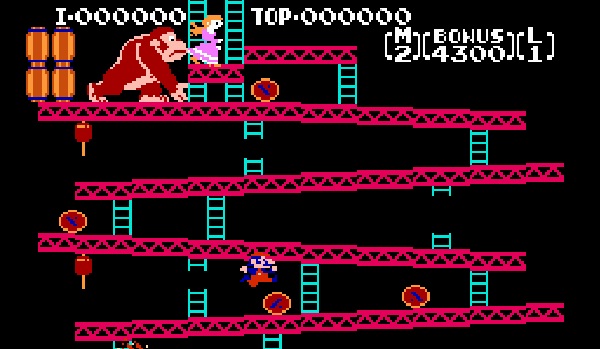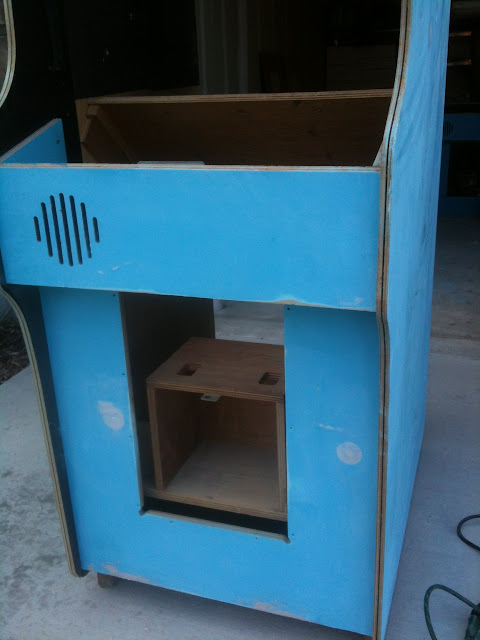I bought some Sherwin Williams paint to the Donkey Kong powder blue specifications and I picked up some primer as well because I wanted to make sure I started my blue paint on a clean base of primer. If I painted blue directly onto the bondo and old paint the paint would sit differently on the two materials. I poured out my primer and went to town, uneasy of the ominous storm clouds heading my way. After two coats of primer it was starting to look like Space Ghost.
I was able to manage a coat of blue that evening in the garage, during the rain. Sorry for the somewhat blurry images. I've been using my cell phone camera for convenience. See, now we're getting somewhere:
I used rollers for the coats of paint. The surface would have been smoother if I had used a paint gun, but I didn't want to spend more money on extra equipment, rentals, etc. so I made due. The plan was to sand it with a fine sand paper between coats. I ended up getting carried away and putting three coats of blue onto the cabinet without sanding. When I went back to sand it I realized my mistake. With each consecutive coat of paint put on by a roller the surface gets more and more rough! I ended up sanding and sanding the surface with both electric and hand sanders to bring the surface smooth again. I should have either hand sanded between coats like I had planned or used a sprayer. Oh well. Lesson learned.
On Friday night I took the tape off and the next step was to replace the base with the one I had constructed a few weeks ago for my older cab (DK1). DK2 needed a new base as well. It was missing the front 1x4 of the square. Using a flathead screwdriver as a lever I was able to rip out the old boards. There were all sorts of goodies in there—cobwebs, grime, spider egg sacks, and other unidentified insect creations.
I now had about 20 staples to remove from the bottom. I pulled out about 8 when I realized that some of the staples were laying underneath boards that were screwed into the inside of the cabinet. I aborted my fruitless plan and instead hammered the staples flat to the surface.
I measured and screwed my new base on from the inside. Now it was time to do some touchups with the blue and then sand and tape it off in preparation for the black paint.
After a couple coats of black it was looking great. I used the same Behr primer/paint that I had used when I painted the base. I also picked up some black, rust-resistant spray paint for the metal frames and coin door. The frames rest above and below the marquee to help keep it in place. These turned out really good.
I took off the tape and admired my work. It's amazing what a difference new paint makes. It will look even better when the t-molding is installed.
I replaced the serial number plaque. It looks nice against the new black paint.
Then I couldn't help myself. I had to move my power transformer, speaker, and wiring into the new cabinet. Since the Japanese Sanyo 20EZ monitor and the light run off of Japanese 100 volts and America uses 120 volts, this little unit converts the American voltage to run the Japanese equipment. Charming.
The speaker. There are several green wires that are grounded to random screws throughout the cabinet. I made sure to take pictures of the proper position of things before I ripped everything out so I wouldn't forget.
I screwed in my Japanese light fixture and fed the wire back through the back to plug into the power transformer.
Then I decided to test the power, just to make sure everything was working properly. I hooked up the wiring and flipped the switch. It's alive! Alive!!! You'll also noticed I placed the hardware for the top and bottom marquee braces that I had repainted.
It's starting to look really nice and I can't wait to move it back into my basement, where I will work on the rest of the small pieces. It's really going to look good once I install the t-moldings on the sides of the cabinet again. That's probably the next step, as well as replacing the power cord, which has exposed wires in several places. I'll need to buy a new cord, strip the wires at the end, and splice them into the Molex connector.











































